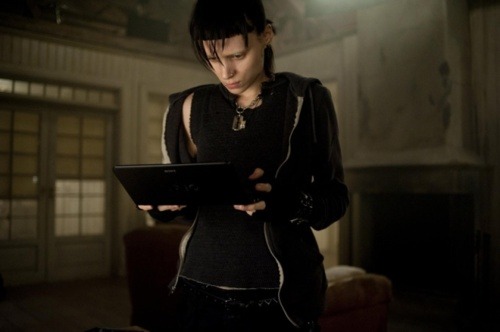Monday, January 30, 2012
Remembering 2011
We have cried, we have laughed, we have done both simultaneously. I watched dear friends on the brink of meltdowns over their shows, life, perhaps even art in general. This is how we become. So a few of our brilliant minds have left us for the other world, and a few newbies have joined the ranks, both of these statements are just as exciting. I will miss these people but what I learned from them in this mutual struggle to share our vision, is something rather beautiful, that I will keep to myself so you don't all gag at my sappy anectdotes. But we are rolling again! Gearing up, getting ready...what will happen next? Not even I can tell.
This being said... do not forget who you have around you, learn to enjoy the rush, listen deeply, impact eachother.
xoxo,
Charlie
Tuesday, January 17, 2012
Tuesday, January 10, 2012
Just a tiny plug for being aware (and being less of a hermit)

Thursday, January 5, 2012
Movies for Photography: The Girl With The Dragon Tattoo 2011

David Fincher's Photographic "Pop" Masterpiece with Rooney Mara
Hot off the success of the Social Network, David Fincher has given us another masterpiece of a film that is surely to be overlooked this year by the academy. But what is it that clearly makes this film stand out above the Swedish film and the book? How is it better then any other movie I have seen this year? There are three traits this film has that positions it as a modern day masterpiece. First, the clear self-awareness of its “pop” gives Fincher a sweeping sense of clarity to continuously stitch scene to scene, and photograph to photograph. Through this acquired perception, Fincher is given domain over the content of the story itself. I have seen the Swedish film, and though I have not read the book, it is to my understanding that the actual mystery of the narrative is rather tame and redundant. The average American household is primed with these kinds of investigative thrillers every night. Without Noomi Rapace’s performance as Lisbeth Salander , the Swedish film falls into the same course of the CSI and Law and Order franchises. This is where Fincher’s adaptation exceeds the source material’s flaws, by exteriorizing the mystery and attentively exposing the dangerous uses and misuses of the acts in research itself. This has been brought forward already by other various critics and most notably by Ignatiy Vishnevestky’s essay, In the Process of Investigation: David Fincher and The Girl with the Dragon Tattoo.Vishnevestky’s states, “ The Girl with the Dragon Tattoo, would sound more like a surveillance transcript than a thriller if it were broken down scene by scene.”
This ultimately leads into the films secondary trait that deducts the analysis of investigation further into the medium of photography. Throughout the film there is an uninterrupted grind between two different functions photography places on the narrative of this feature. Within the film’s cold natured content, the mystery is driven directly by surveillance and snapshots. Not only is Lisbeth most-prone to documentation and setting up small spy-camera contraptions (one circumstance where the lens truly liberates her after a most horrid scene); she also already lives in a voyeuristic role watching her hacked victims through the transparent interface of her laptop. As she patrols the digital network, her counterpart, Daniel Craig’s Mikael Blomkist is introduced to an older, much familiar system of documents, strolling through binders of negatives, albums of snapshots, each date, figure, blur, camera angle pointing towards the eventual killer. In the way finger-prints on a gun would suggest the suspect who held the murder weapon, Fincher accentuates the photograph as the leading piece of evidence, increasing our anxiety on the objectiveness of photography and its transcendent capabilities.

Now the final attribute, which encompasses the other two deliberately and detaches the film from any other this year, is the role of Rooney Mara.
Mara has an assortment of responsibilities here. The two most important ones being, selling herself as the character of Lisbeth Salander while simultaneously posing herself as David Fincher’s meticulous distraction. Media scholar Marshall McLuhan once described the “content” of a medium as a juicy piece of meat carried by the burglar to distract the watchdog of the mind. Comparing Mara’s Salander to a “juicy piece of meat” within the context of the actual story has its withdrawals and is actually quite appalling; however from an outlying perspective on Fincher’s directorial process, she fits this role seamlessly, racing through the dullness of the mystery itself, decisively expanding into the more thematic appendages of the feature. As Blomkvist was the model for author Stieg Larsson, Mara’s Salander is the imprint of director David Fincher. The painstaking precision of both Fincher and Mara’s Salander gives us the only subjective read throughout the whole method of researching and adapting.
In this circumstance of “pop”, we must begin to question the intentions of a director adapting a sub par book to benefit his own style and experience, ultimately exalting a more viable piece of Art. Minimizing the story’s purpose to intellectualize the audience’s understanding of the camera, both on screen and beyond, heightens the prospect of awareness but can also disrupt cathartic measurements.
The Girl with the Dragon Tattoo transcends this dichotomy due to Fincher’s appreciation of adaptation. Into the shroud coldness of the medium that is photography, ascends Rooney Mara’s portrayal of Lisbeth Salander; both Fincher’s memorial to the late Stieg Larsson, and his Christmas present to us cinema-goers.

